PROMPTnations: mAI type presents works by contemporary AI artists from various parts of the world, showcasing new dimensions of working with generative outputs in their most original, "raw" form. These pieces reveal innovative approaches to using AI as a creative tool in typography, emphasizing the experimental nature of the process and offering freer, more expressive outputs that blur the lines between free artistic creation and experimental design.
Jazno Francoeur, a 1992 graduate of the Kansas City Art Institute, currently leads the animation program at the DigiPen Institute of Technology campus in Singapore. Over the course of his career, Francoeur has lectured across Asia on animation and has been widely featured in media. He has also worked at Lucasfilm Animation and is a composer and producer for his own band, Mercymachine, which has released three studio albums and earned a Bronze Medal at the Park City Music Festival.
Throughout his animation career, Francoeur contributed to major Disney films such as Aladdin, The Lion King, Beauty and the Beast, and Lilo & Stitch. In 2004, he transitioned to DigiPen, where he has taught animation and character design, eventually leading the animation curriculum in Singapore.
Currently, Jazno Francoeur is exploring AI-generated video. For this exhibition, he has created a video that showcases the potential of AI in handling complex compositions, visual coherence, fluid transitions, and control over the final output. He also composed the music for the video, performed by his band, Mercymachine..
An Exploration of Hyperdimensional Spaces
Prompt:
She pushes the cat like a sacrifice over the soft edge of the waterbed to mingle on the rug in the sunlight with an old copy of “Dianetics” and two cigarette butts. In the window, the dark silhouettes of static figures conform to the thin orange curtains, frozen like insects in primordial amber or Greeks adorning a black-figure vase— a primitive diorama where light
projects odd shadows onto a bookcase against the back wall (while her sleeping mind similarly projects the obverse world
behind her eyes, with its abstract contours). style of Francis Bacon, David Hockney, and Diebenkorn::2 Penrose tiling, Girih tiles, elliptical curve algorithm, 2d to 3D mirrored 4D tesseracts + optimized photon capture + dynamic fractured motion blur + blues interpolating to green:: ray tracing, subsurface scattering, bounced light, global illumination, caustics, volumetric lighting --niji 5 --s 75 --ar 2:1
Saurabh Mhatre is a research scientist at the BioInteractive Design Lab at Northeastern University. Previously, he served as a senior research fellow at the Material Processes and Systems Group (MaP+S) and the Center for Green Buildings and Cities at the Harvard Graduate School of Design. His interdisciplinary work at the intersection of design and science focuses on innovations in smart materials, 3D printing, and origami-inspired robotics.
For the mAI type exhibition, Mhatre has created a series of AI-generated outputs that explore and experiment with the illusionistic potential of typography. This collection delves into visual illusions, optical effects, and unexpected typographic forms, emerging from the fusion of creativity and generative AI tools.
Matias del Campo is an architect, designer, and theorist, leading the Laboratory for Architecture and Artificial Intelligence (ARIL) at the New York Institute of Technology (NYIT).
In 2003, he co-founded SPAN Studio in Vienna, which focuses on integrating cutting-edge technological innovations with architectural production. His approach, termed "design ecology," combines computational methods with philosophical inquiry.
Del Campo has received prestigious accolades, including the Accelerate@CERN fellowship and the AIA Studio Prize, and serves on the ACADIA board. Works by SPAN Studio are part of collections in institutions such as FRAC, MAK Vienna, and Albertina. He is also the author of publications like Neural Architecture and Artificial Intelligence and Architecture and holds a faculty position at NYIT, where he bridges research in artificial intelligence and architecture.
For the mAI type exhibition, del Campo presents archival works that investigate latent space exploration and research in architectural schematics and drawings. The showcased outputs explore symbols, dimensions, and annotations, revealing new possibilities in visualizing and interpreting architectural data. These explorations merge artificial intelligence with traditional principles of architectural representation.
Dr. Miro Roman, is an assistant at the House of Coded Objects (UIBK Innsbruck) and a senior lecturer at Studio Meteora (ETH Zurich). His work focuses on integrating artificial intelligence, big data, and digital technologies with design, architecture, art, and fashion. His research, writing, and creative practice center around developing synthetic alphabets as a means of navigating the overload of information, treating computational literacy as a fundamental skill.
He is the co-author of A Play Among Books (2022), a book based on his PhD research that bridges humanistic and scientific perspectives. Roman is also the creator of the Xenotheka library and the Ask Alice tool, both of which support his teaching and research. In collaboration with Silvio Vujčić, he developed AI fashion designer SOLL and the brand E.A. 1/1 A.I., which led to the creation of the film Planet SOLL and the magazine STORYBOOK: ON RECYCLING (2024).
His work has been exhibited at the London Design Biennale, Taipei Fine Arts Museum, and other venues, and he has published in leading journals such as A+U and Arch+. Roman has also lectured at numerous universities, including TU Berlin, Politecnico di Milano, and Southeast University Nanjing.
Title: Portrait of Google on 15 November 2017
Author: Alice_ch3n81
Website: ask.alice-ch3n81.net
Technique: This work explores the theme of synthetic symbols, icons, and glyphs. The visualization is based on the analysis of 100,000 images associated with Google's most frequently used words. The data classification was conducted using a Self-Organizing Map (SOM) algorithm, creating a structured representation of digital culture and linguistic trends.
https://alice-ch3n81.net/files/data/Roman_Portrait_of_Google.pdf
Thomas Haferlach is the founder and data scientist behind Pollinations.AI, a platform dedicated to democratizing generative art through artificial intelligence. After studying AI and computer science at the University of Edinburgh, he spent nine years in São Paulo, where he co-founded the Voodoohop art collective and created interactive installations that merge art, research, and technology. Today, he focuses on generative audio modeling and works as a senior machine learning specialist for Pixelynx, a music AI company founded by Deadmau5 and Richie Hawtin.
His animation COSMIC ENTHUSHIASTS AItype of Cosqunly depicts a surreal landscape featuring a waterfall and trees illuminated by vibrant neon colors that shift through different shades. The overall effect, enhanced by AI-generated audio, creates a mystical atmosphere tied to a fantastic world, where digital and natural aesthetics blend into a hypnotic visual experience.
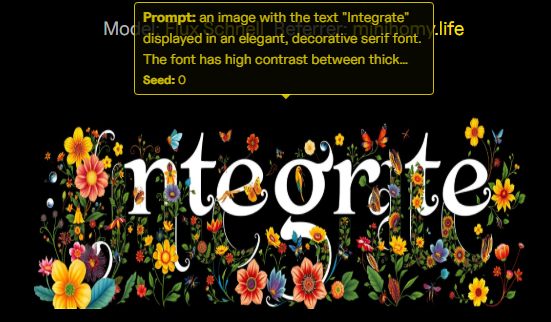
Thomas developed a real-time typographic generation system for the web platform Pollinations.ai. The resulting fonts and lettering incorporate decorative motifs such as flowers and insects, created using generative algorithms. This approach enables a fluid and dynamic transformation of text elements, pushing the boundaries of traditional typography..
Giovanni Muzio (Italy) – Creative Technologist and New Media Artist (kesson.io)
Giovanni Muzio, known as Kesson, is a new media artist specializing in computational aesthetics, algorithm exploration, and the imperfections of machine learning. His work combines real-time graphics and artificial intelligence, creating interactive experiences that push the boundaries of traditional perceptions of art and technology.
For the exhibition, he focused on visualizing PyTorch tensors during image sampling, using data from the Stable Diffusion 2 model. The resulting point cloud visualization was inspired by the t-SNE method, which is used for high-dimensional data visualization. The piece was developed using custom code in OpenGL and GLSL shaders, compiled in Java with Processing for simplicity and execution speed.
Péter W. Szábo is a Romanian programmer and artificial intelligence expert, known as the founder of Tengr.ai and Promptomania. A renowned speaker at leading machine learning conferences and a pioneer in generative models, he has been instrumental in advancing AI-driven creativity.
For the exhibition, he presents a visual artwork entirely authored by Tengr.ai, the AI model he developed.
The visual composition, generated by Tengr.ai, captivates with its harmonious fusion of realistic details and abstract elements, evoking a futuristic aesthetic. The bold floral motifs and precise linework emphasize the contrast between technology and nature, creating a striking visual impact. The typography, blending minimalist design with modern graphical expression, enhances the work’s dynamic and technological character.
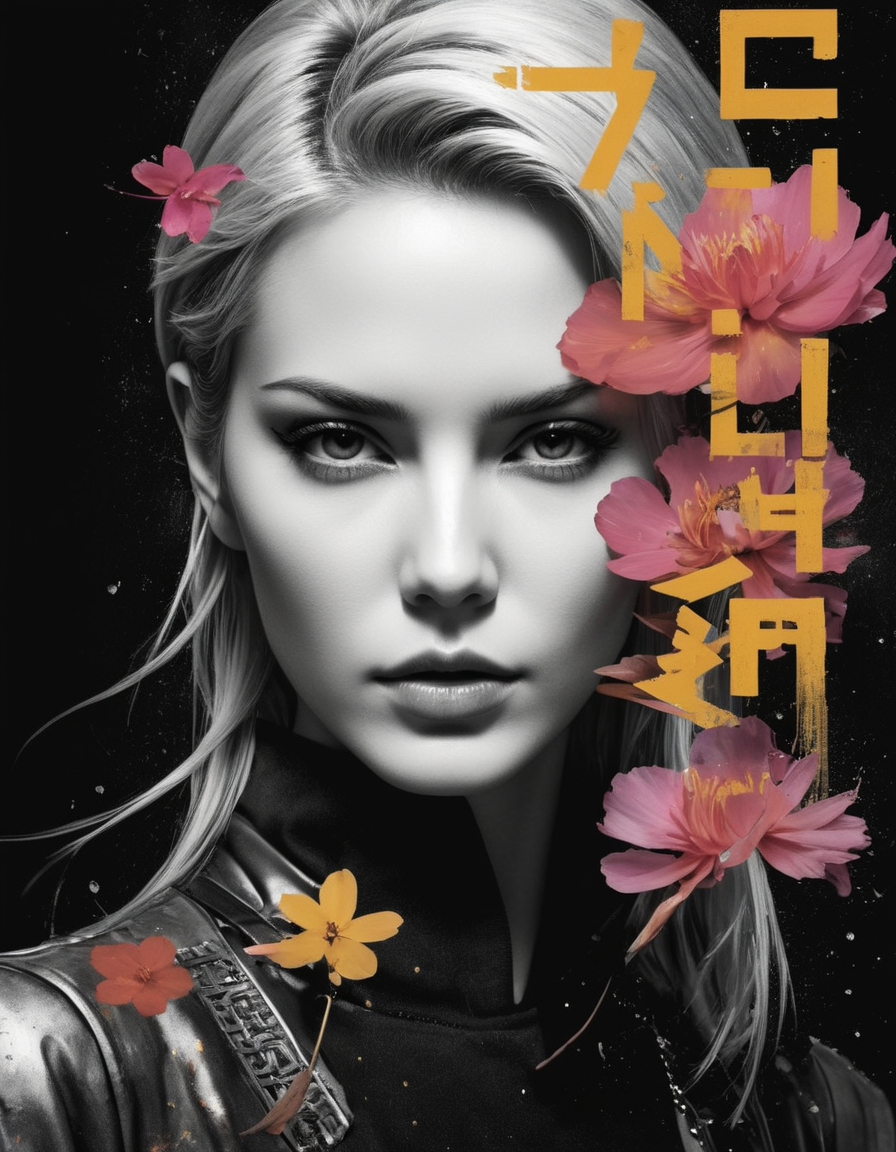
Naveed Anwar, PhD, is a Senior Manager in the Design and Engineering Department at Adidas, Germany. Previously, he completed his PhD studies at TBU in Zlín.
In his fully AI-generated work, he experimented with creating speculative content and altering history. He produced a video titled "1920’s", which envisions an imaginary evolution of Adidas’ product portfolio in the second decade of the 20th century.
Marcel Serrano is a digital creator specializing in AI and the metaverse, leveraging artificial intelligence to develop innovative visuals and automate creative processes. His work helps brands explore new ways to connect with audiences through personalized AI tools and inspirational design. Operating at the intersection of technology and art, his creations reflect a deep understanding of the metaverse and its potential for the future of the creative industry.
His work merges geometric forms and typography, taking an experimental approach where letters are not just carriers of meaning but become three-dimensional objects. Elements projecting into sculptural forms give the pieces a sense of monumentality and dynamism. The ornamental details, curvatures, and layering create a complex visual language, balancing between calligraphic precision and sculptural expressiveness.
These generative outputs can be seen as a fusion of tradition and modernity, where classical typographic principles find new applications in the digital realm. The works symbolize artistic freedom and the possibilities of AI-generated art, redefining the role of typography in a rapidly evolving creative landscape.
Falah G. Salih is an Iraqi programmer specializing in machine learning, developing models that reflect Arab culture and visual traditions.
For the exhibition, he created a work that blends Islamic architecture, calligraphy, and ornamental art. The composition features a mosque with minarets, surrounded by traditional Arabic calligraphy, utilizing a serif-style script that echoes classical handwriting, adding both sophistication and historical depth to the text.
This piece exemplifies a unique fusion of modern technology, traditional typography, and the deeply rooted aesthetics of the Arab world, highlighting the intersection of cultural heritage and AI-driven design
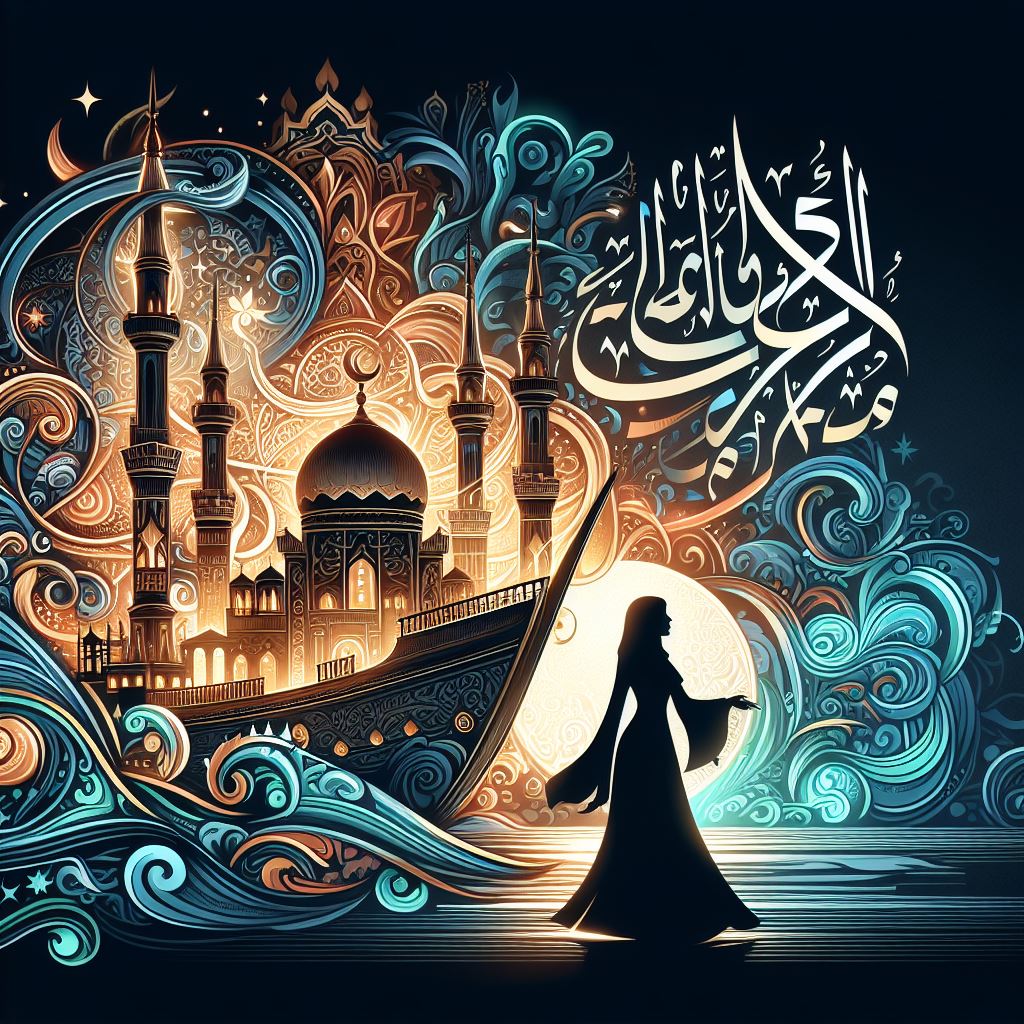
Brian Jackson is an AI artist and brand designer with over 35 years of experience in design, having collaborated with major clients such as IBM, Ferrari, Universal Pictures, and Google. With extensive expertise in print, digital media, and environmental design, his work helps brands communicate effectively and achieve business goals through a strong visual language.
His AI-generated visual output features a stylized letter combined with gradient tones reminiscent of a sunset, creating a modern and dynamic impression. The minimalist form and depth of color evoke the elegance and freshness of contemporary design, while the subtle color transitions ensure visual fluidity and balance.
This design presents a sophisticated exploration of the connection between traditional typography and modern technologies, demonstrating the harmonious blend of AI-driven creativity with timeless design principles.
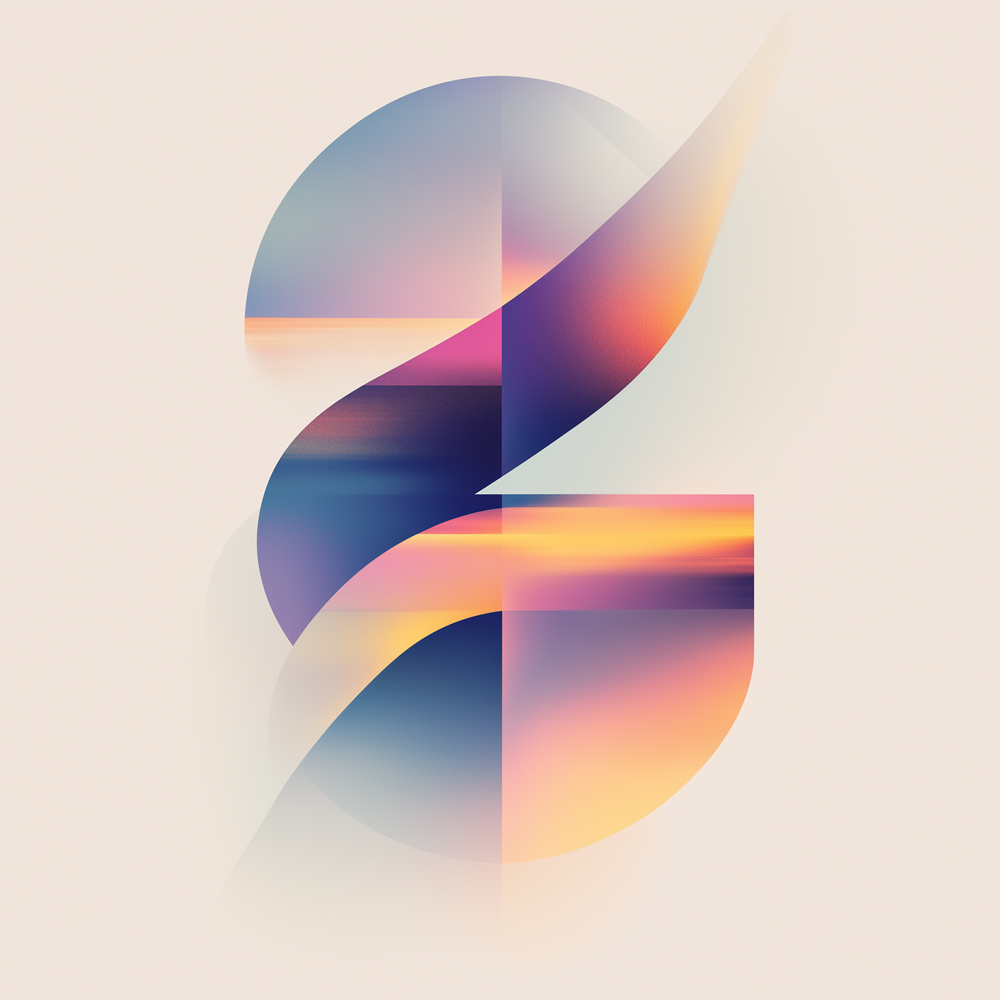
Geometry in transition
Marc Librescu is an American AI creator who earned a BFA from the School of Visual Arts. Actively engaged in digital and generative art, he also maintains a career as an independent writer, focusing on the technology industry.
His AI-generated work, strongly influenced by surrealism, gained international recognition at the virtual exhibition "Prompt Generations," organized by Arte.Go, a pioneering Italian platform for digital art. Now based in Southern California, Marc is expanding his artistic scope by writing screenplays, further exploring narrative storytelling and its intersection with AI-driven art.
For the mAI type exhibition, Marc presents a piece where the monumental shape of the moon subtly forms the letter “C”, integrating typographic elements into the composition. This fusion of symbolic form and literary interpretation showcases how generative AI can blend visual abstraction with conceptual depth, pushing the boundaries of typographic representation.
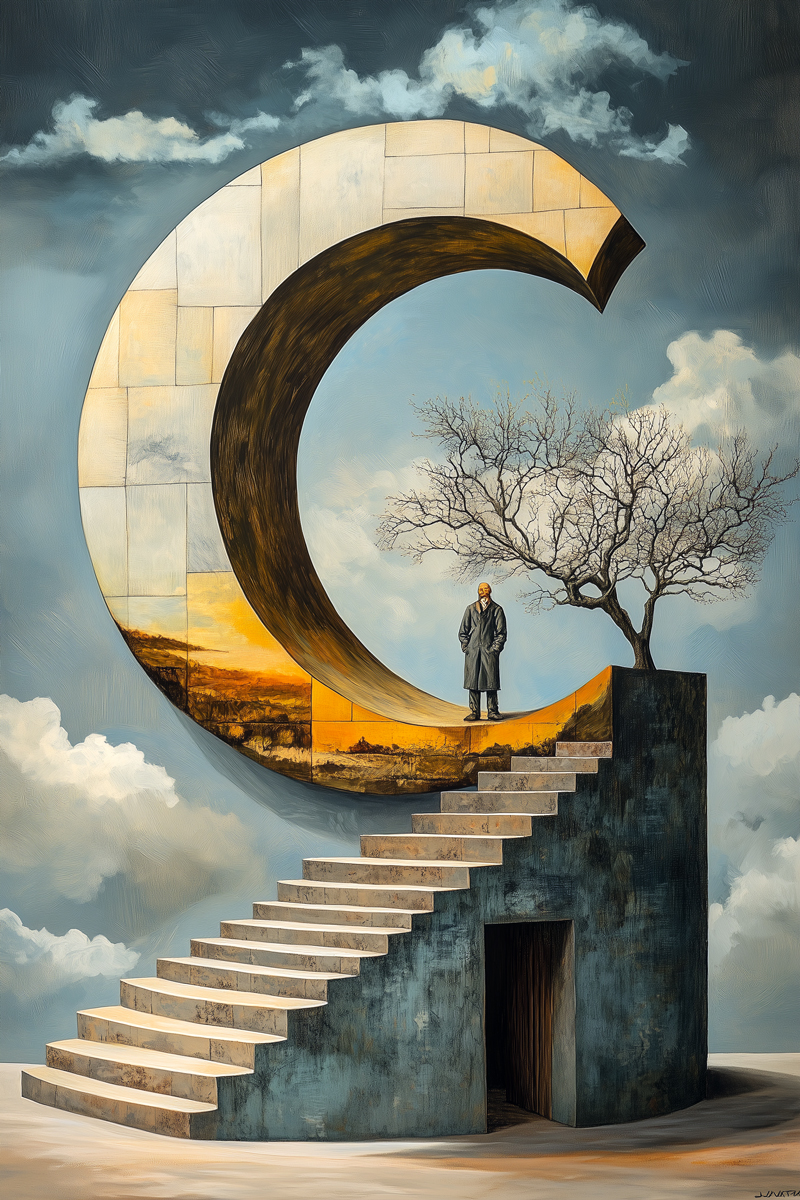
Matthew Haggett is an AI creator and graphic designer with over 20 years of experience in marketing, graphic design, and communication. Having worked in agencies, corporate environments, and as a consultant, he specializes in strategy, web/digital design, social media, copywriting, print, advertising, logo/branding, and illustration. Matthew is also the administrator of the official MidJourney Facebook page.
This AI-generated piece, created using MidJourney, blends a dark liminal atmosphere with a strong surrealist undertone. The scene of an abandoned swimming pool exudes melancholy through muted colors, a misty haze, and the absence of human presence. A neon sign reading "VOID" draws attention with its red glow, sharply contrasting with the surrounding cool tones, creating a striking dramatic effect.
Characteristic of MidJourney’s high level of detail, elements such as tiles, water reflections, and misty air are rendered with precision, lending the scene a sense of realism while maintaining a dreamlike, emotive quality—a signature of AI-generated visual compositions.
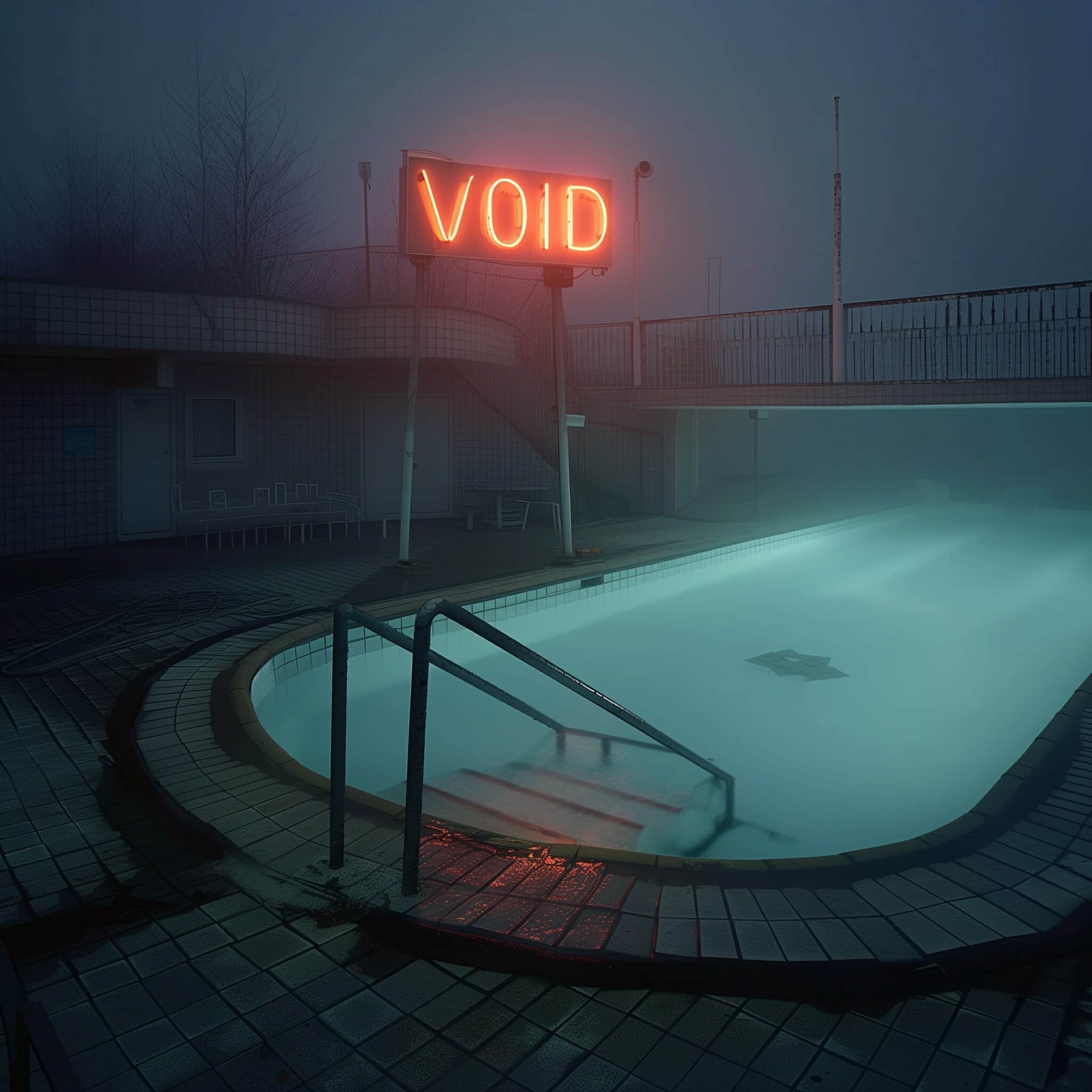
Night swim
The artwork L'esperluette (Ampersand) by French creator Jean-Pascal Mouton was generated using MidJourney. This composition employs geometric abstraction, featuring bold shapes and a contrasting color palette of orange, blue, yellow, and black.
Lines and curves intertwine to form a dynamic composition, evoking a sense of movement or transformation. The dark background, enriched with textures and subtle details, resembles a futuristic or technological landscape, adding a modern touch to the piece.
The artwork captivates with its precision, interplay of light and shadow, and fusion of organic and mechanical elements, making it a striking example of AI-driven visual exploration.
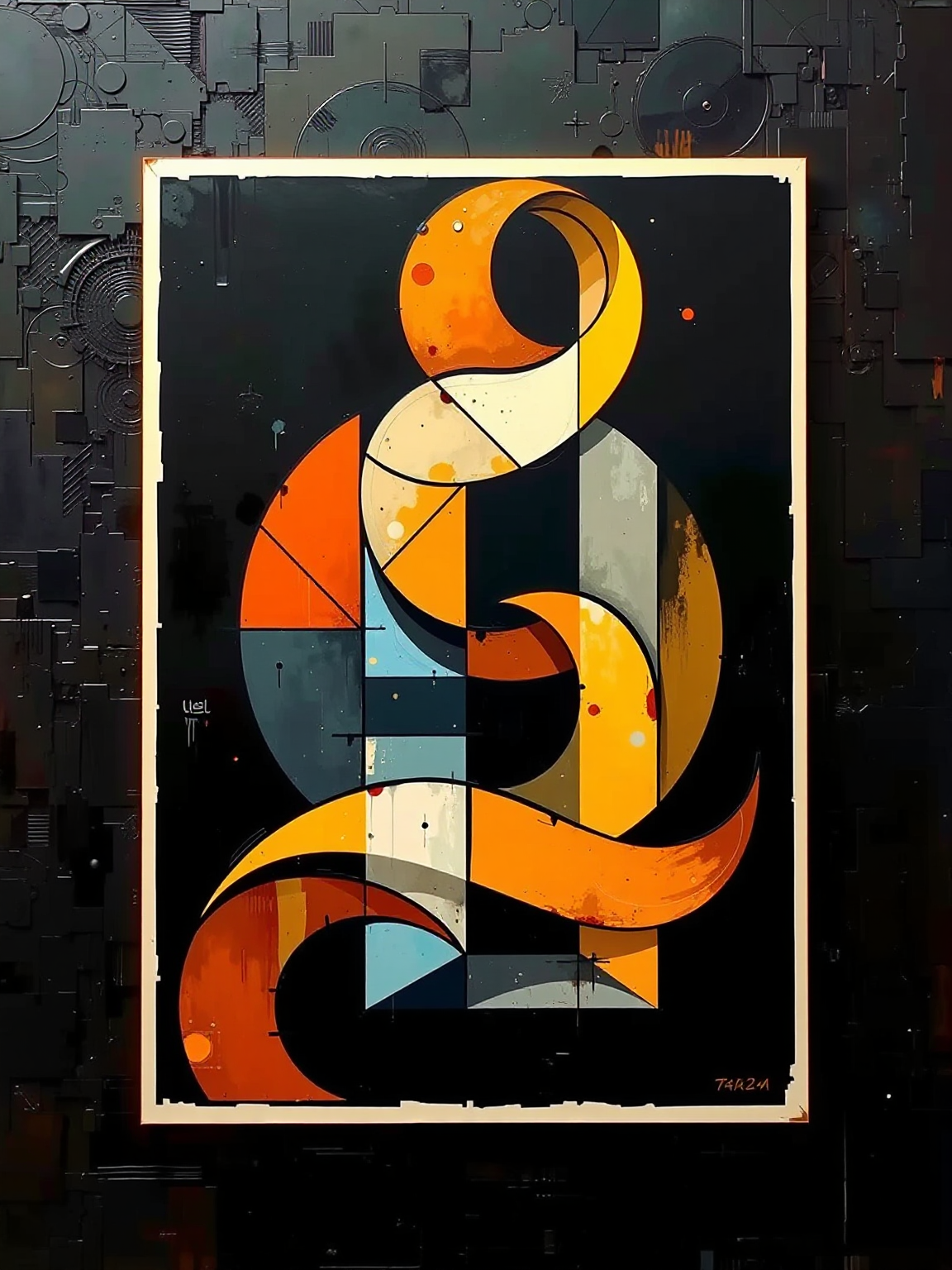
L'esperluette
The artwork Decoding by Valeryia Truskavetska explores the concept of decomposition as a fundamental principle of the creative process, where deconstruction leads to new forms of expression. The fragmented symbols flowing in organic shapes represent the symbiosis between human intuition and algorithmic precision, highlighting the interdependence of creativity and technology.
Optical illusions and infinite loops function as visual metaphors for an endless cycle of discovery, in which graphic elements become not only a medium but also an interface bridging the analog and digital realms.
While typography is not explicitly present in the work, its influence is evident in the composition and arrangement of fragmented shapes. The deconstruction and fragmentation of graphic elements can be interpreted as an abstract reflection of typographic principles, transforming into visual elements that relate to the narrative and structural function of text.
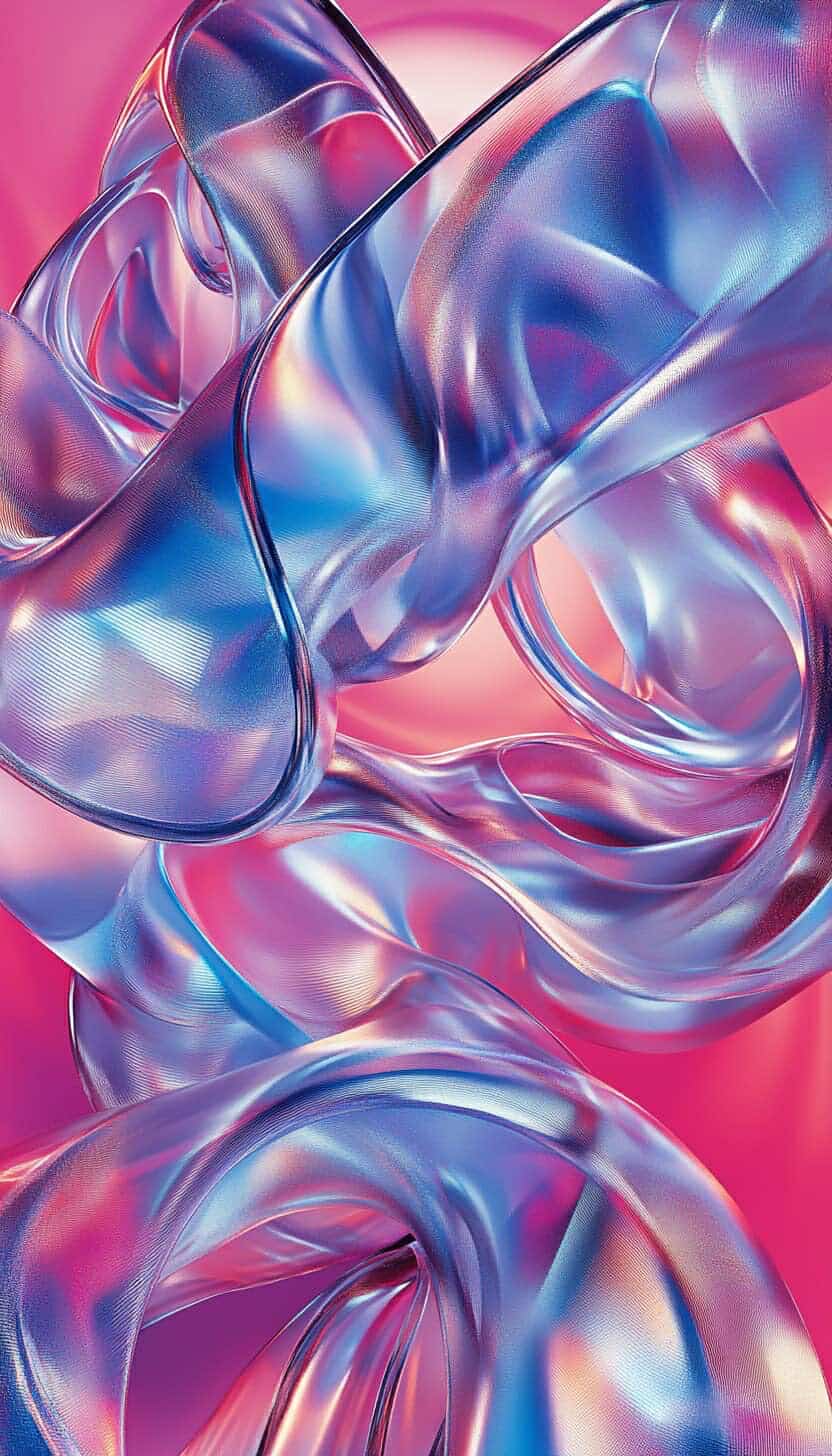
Decoding
An AI-generated video by Dutch AI and new media artist Jawek Kwakman presents an experimental blend of generative art and post-production within a glitch art aesthetic. This piece explores visual deconstruction, where algorithmically generated forms and textures interact with digital “glitches,” creating a hypnotic, layered visual experience.
Here, glitches serve not only as disruptions but also as creative elements, emphasizing the fragility and dynamism of the digital image, while blurring the lines between order and chaos, reality and simulation. The video stands as a compelling example of the fusion between artificial intelligence and experimental digital aesthetics.
It’s a powerful exploration of how technology can redefine artistic expression, playing with our perception and challenging conventional boundaries.
Glitchscrapes

Galerie G18 ve Zlíně
Gallery of the Faculty of Multimedia Communications,
Tomas Bata University in Zlín
Štefánikova 5670, Zlín
Czech republic
